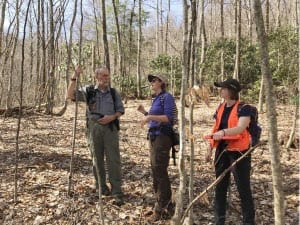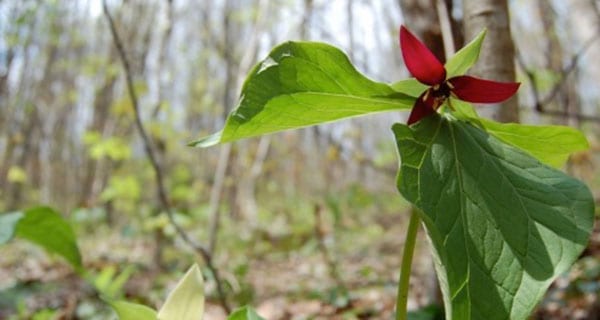
By Russ Oates
Stacy and I came from families that love the outdoors and feel a deep connection with wild things and wild places. Growing up on opposite coasts (Stacy in the Napa Valley of California and me in eastern North Carolina), we were both fortunate to have many opportunities to get outside and enjoy the wonders of Nature. We were married in 1984 and, 4 months later, moved to Alaska where I worked as a Wildlife Biologist for the US Fish and Wildlife Service. Our two daughters were born in Fairbanks in 1986 and 1988, and we settled into family life. In 1995, we decided it was time to get some financial advice to ensure that we could afford to send the girls to college and have a chance of being able to retire. The first thing our new financial advisor said to us was “What are your dreams?” Stacy and I shared an interest in wild lands conservation, so we told the advisor about our dream to protect some woodland. His immediate response was “Buy it now or you never will.”
Although I loved the cypress swamps of my youth, we knew after 10 years of acclimation to Alaska temperatures that we would not be comfortable in the eastern part of NC due to the summer heat and humidity. We decided to look at land in the relatively cool mountains of Virginia and North Carolina.
The search began in May of 1995. Stacy stayed in Alaska with the girls and I headed to NC for a 2 week road trip through the mountains. My father, then 80, still loved to roam the woods with me. We headed out in his old Buick station wagon for northwestern Virginia and worked our way southwest through the mountains, stopping at likely looking parcels we found in the local newspapers we picked up in the small towns along the way. After looking at numerous properties along the way, we found a tract in Yancey County, NC. Although the lower portions of the property had been logged the year before, we decided to check it out.

Thus, the first step towards our goal of protecting forestland was achieved. Now, we had to ensure that the land would be protected beyond our lifetimes for future generations. A conservation easement seemed to be the best way to accomplish our long-term goal.
We contacted the Southern Appalachian Highlands Conservancy to learn more about conservation easements and to see if they would be interested in protecting our property. After several discussions, it was clear to us that a conservation easement was just what we were looking for. The folks at SAHC seemed excited about our land, and their Conservation Director, Michelle Pugliese, walked the property to assess its condition and determine if it possessed adequate conservation values to merit an easement. It passed the test and we have been so happy with their continuing interest and stewardship.
Over the years, I have gotten to know several of the folks at SAHC and really appreciate their deep commitment to conservation. We strongly support their dedication, and decided to become monthly donors because it is a very convenient way to contribute to this important mission.
After looking out airliner windows while flying from Alaska to the lower 48 states numerous times over 30 years, it has become abundantly clear to us that, with the exception of Alaska, most of the ecosystems present in the vast preponderance of US lands (particularly east of the Rocky Mountains) have been drastically altered by human development. There is a tremendous need to conserve and restore these ecosystems to ensure that they can continue to provide clean air, water, and soil and a full suite of biodiversity. Conservation easements, such as those available through SAHC, can help protect functional ecosystems and are an outstanding way to contribute to the security of our children’s futures.”